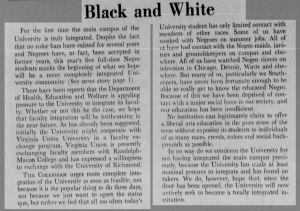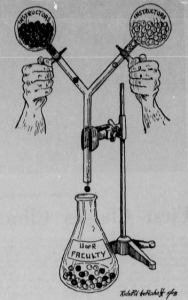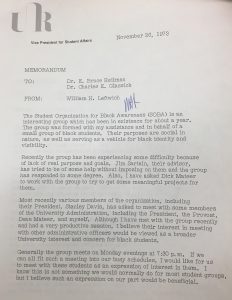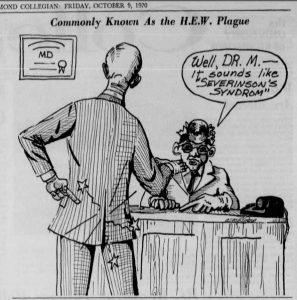This week’s episode takes a step back from the archive and offers a perspective on the recent election.
Uncategorized
Race and Racism in Trump’s America’s America
To be frank I didn’t want to write about the outcome of the election. I didn’t want to have to give it more than half a second of thought. I didn’t want to seriously confront the reality that is before us. In the days following the election a wave of indignation flooded over me and I found myself not even wanting to talk about the results. I felt as though I didn’t owe anyone my insight or a report on how I was feeling. Instead I chose to consume. I gorged on every tweet, op-ed, podcast, Facebook post, etc. that I could find and as I sought to make sense of what had happened I came to understand that my silence was not an option.
In my search for answers I was reminded that although shocking a Trump presidency should not come as surprise. Trump is tragically symptomatic of what America really is. The results of the election are in no way ahistorical. America was, is, and has been cradled in a sordid legacy of racism and discrimination. The very foundation of who we are rests upon the same foundation upon which Donald Trump built his campaign, the preservation of white supremacy. And sure, there’s room to acknowledge the ways in which progress has been made in this country but there is obviously still so much more work to do.
We here in the ivory tower are not immune to the existing structures of larger society. Masked as bastions of progress and innovative thinking, higher education institutions often replicate patterns of injustice. The University of Richmond is no stranger to the replication process, whether we turn to the on-campus minstrel shows of the 50s, resistance to integration in the 60s, or the fight to maintain “Dixie” and the Confederate flag as university symbols in the 70s. Although the University has begun to move from its reputation as an exclusive, all-white, Southern institution it still posits the stories and contributions of white men as central to the narrative and neglects to acknowledge the vital role that people from minority groups have played in the University’s success. That privileging of whiteness in University history does little to dismantle the underbelly of white supremacy.
Now more than ever projects like this matter. People need to know and understand actual silenced voices. People need to confront the University’s racist past and its implications in the present. We need to reclaim that history and uncover the stories of those who currently exist on the margins. We, myself included, must continue to publicly engage in questions of the past in order to continue the undoing of racial inequality.
Revisiting “Dixie”
In light of new evidence found in the archive, this week’s episode revisits the 1971 controversy surrounding the now-defunct University Band’s use of the song “Dixie”.
This Week in the Archive: Editorial Appeal for Faculty Integration
 Despite having integrated downtown night courses in 1964, the University of Richmond remained segregated on its main campus until 1968. Early that year the Board of Trustees approved a measure to accept federal funding for projects outside of capital construction. In part, the funding meant that the University had to comply with federal statutes such as the Civil Rights Act of 1964. The act prohibited discrimination on the basis of race, color, or national origin in any program receiving federal funds. Although the aid would not have been available until the following school year the University had to prepare to meet prerequisite qualifications for certain grants. Part of those prerequisite qualifications was compliance with the Civil Rights Act. During this time attitudes toward integration on campus greatly differed with some calling for swift action and others dragging their feet into the inevitable.
Despite having integrated downtown night courses in 1964, the University of Richmond remained segregated on its main campus until 1968. Early that year the Board of Trustees approved a measure to accept federal funding for projects outside of capital construction. In part, the funding meant that the University had to comply with federal statutes such as the Civil Rights Act of 1964. The act prohibited discrimination on the basis of race, color, or national origin in any program receiving federal funds. Although the aid would not have been available until the following school year the University had to prepare to meet prerequisite qualifications for certain grants. Part of those prerequisite qualifications was compliance with the Civil Rights Act. During this time attitudes toward integration on campus greatly differed with some calling for swift action and others dragging their feet into the inevitable.
Conversely, the Department of Health, Education and Welfare (HEW), one of the federal agencies charged with enforcing the Civil Rights Act of 1964, was steadfast and exacting in its mission to integrate schools. HEW officials in Virginia began pressuring the University to integrate not only its student body but also its faculty. An editorial published in The Collegian on September 20, 1968 echoed HEW’s plea for faculty integration. Writing on behalf of The Collegian staff, this editorialist noted that The Collegian’s stance on integration was not meant to be seditious or in vogue with the times but rather earnestly rooted in the belief that University of Richmond students did not have enough contact with people of other races and “have never been fortunate enough to really get to know the educated Negro.” The editorialist went on to contend that the university could not claim to be liberal arts if it did not expose students to those of different “races, creeds, colors and social backgrounds.”
Interestingly, the editorialist made no appeal to claims of justice or civil rights even though the push for integration of any kind was propelled by civil rights legislation. Moreover, the piece presents white students as the main beneficiaries of faculty integration and does not address the implications of this on black faculty. The sentiment there is ‘if we hire black faculty or do a faculty exchange with a historically black college or university then all will be well.’ The piece does little to nuance the argument and paints the issue as black and white.
 The accompanying cartoon functions similarly. The artist chose to depict faculty integration with scientific imagery. In the image an apparatus holds two glass bulbs labeled “instructors”. One bulb contains black molecules and the other contains white molecules, which are taken to represent black and white faculty respectively. At the bottom of the image a flask labeled “U of R Faculty” contains a fairly equal mix of both black and white molecules. The choice to represent faculty integration with an image that evokes scientific study suggests that there can be a “science” to the process in a way that strips the problem of its context and sordid history. The hands with no body attached also evoke a detachment from the lived human experience of fighting for integration. Although the written piece makes appeals to humanity and improvement thereof, the appeals are limited to conceptualizations of white humanity. Both the editorial and the cartoon function to create the illusion of an alchemy of integration in a way that does not humanize the actual experience of integration for black people.
The accompanying cartoon functions similarly. The artist chose to depict faculty integration with scientific imagery. In the image an apparatus holds two glass bulbs labeled “instructors”. One bulb contains black molecules and the other contains white molecules, which are taken to represent black and white faculty respectively. At the bottom of the image a flask labeled “U of R Faculty” contains a fairly equal mix of both black and white molecules. The choice to represent faculty integration with an image that evokes scientific study suggests that there can be a “science” to the process in a way that strips the problem of its context and sordid history. The hands with no body attached also evoke a detachment from the lived human experience of fighting for integration. Although the written piece makes appeals to humanity and improvement thereof, the appeals are limited to conceptualizations of white humanity. Both the editorial and the cartoon function to create the illusion of an alchemy of integration in a way that does not humanize the actual experience of integration for black people.
On Racial Awareness
People say that talking about race is hard, but is it really? This week on Expanding the Ivory Tower Victoria explores a “Racial Awareness Session” that took place on campus in 1971 involving students from the University of Richmond and Virginia Union University, a nearby historically black university. During the session the students were prompted to ask questions of themselves and each other through the lens of race and racism.
This Week in the Archive: SOBA Memo
 On November 26, 1973 then-vice president of student affairs, William H. Leftwich, sent a memo to university president, Dr. E. Bruce Heilman and provost, Dr. Charles H. Glassick, concerning the Student Organization for Black Awareness (SOBA). According to Leftwich, SOBA had been in existence for about a year and was formed with his help and continued under the guidance of sociology professor Dr. James Sartain. Leftwich noted that the group aimed to serve as a “vehicle for black identity and visibility” on campus but in his opinion lacked “real purpose and goals.” Despite having stated the group’s purpose in the previous paragraph, Leftwich’s assertion that the group lacked real purpose suggests that he did not consider their claims to a shared identity as a legitimate cause for group formation. In the memo Leftwich added that he had asked Richard Mateer, the dean of Richmond College, to help the group get some “meaningful projects” off the ground.
On November 26, 1973 then-vice president of student affairs, William H. Leftwich, sent a memo to university president, Dr. E. Bruce Heilman and provost, Dr. Charles H. Glassick, concerning the Student Organization for Black Awareness (SOBA). According to Leftwich, SOBA had been in existence for about a year and was formed with his help and continued under the guidance of sociology professor Dr. James Sartain. Leftwich noted that the group aimed to serve as a “vehicle for black identity and visibility” on campus but in his opinion lacked “real purpose and goals.” Despite having stated the group’s purpose in the previous paragraph, Leftwich’s assertion that the group lacked real purpose suggests that he did not consider their claims to a shared identity as a legitimate cause for group formation. In the memo Leftwich added that he had asked Richard Mateer, the dean of Richmond College, to help the group get some “meaningful projects” off the ground.
After introducing SOBA, Leftwich went on to ask, on behalf of the group, if Heilman and Glassick would be willing to meet with them. He acknowledged that student meetings with administrators were not typical but emphasized that it “would be viewed as a broader University interest and concern for black students.” Leftwich presented the meeting as a symbolic gesture and did not indicate that it would be anything beyond “an expression of interest.” It is interesting that Leftwich posited the meeting as a mere expression of interest in black students even though high-level administrators were invited to participate in the conversation. As president, Dr. Heilman in particular had the authority to bring about broad-sweeping change to the university or at the very least present possible changes to the Board of Trustees. His presence at the meeting had the power to be more than symbolic.
The proposed meeting offered a chance to hear directly from black students, implement new policies, and make the university better but instead that opportunity was squandered for the sake of symbolism. It is great that black students had the chance to be heard but it seems as though their grievances might have fallen on deaf ears. The demographic composition of the proposed meeting showed an inherent defect in the university system. All of the invited administrators were white men. At the time there were no full-time black faculty or high-level staff at the school. Black students were made to plead their case to those who may have been sympathetic to their cause but not at all familiar with their struggle. This memo implies that the administration was unwilling to seriously consider the plight of black students at the school and instead chose to make symbolic concessions.
Let’s Push Back
This week on Expanding the Ivory Tower we consider two articles, one written in 1973 and the other in 2016, that chronicle black students’ critiques of the university.
This Week in the Archive: The HEW Plague
 This image appeared in the October 9, 1970 edition of The Collegian, the student newspaper at the University of Richmond. The cartoon depicts Dr. George Modlin, former university president, pointing to what seems to be a pain in his backside. The doctor in the cartoon diagnoses Modlin with a fictional ailment referred to as Severinson’s Syndrome. The image caption explains that the ailment is also “commonly known as the HEW Plague.” In effect, the cartoon implies that Severinson’s Syndrome or the more commonly the HEW Plague is what’s causing the pain in Dr. Modlin’s backside.
This image appeared in the October 9, 1970 edition of The Collegian, the student newspaper at the University of Richmond. The cartoon depicts Dr. George Modlin, former university president, pointing to what seems to be a pain in his backside. The doctor in the cartoon diagnoses Modlin with a fictional ailment referred to as Severinson’s Syndrome. The image caption explains that the ailment is also “commonly known as the HEW Plague.” In effect, the cartoon implies that Severinson’s Syndrome or the more commonly the HEW Plague is what’s causing the pain in Dr. Modlin’s backside.
Severinson’s Syndrome alludes to Dr. Eloise Severinson, the regional civil rights director for the now-defunct Department of Health, Education and Welfare (HEW). Appointed to the position in 1968, Dr. Severinson was tasked with helping institutions comply with Title VI of the Civil Rights Act of 1964, which prohibited discrimination on the basis of race, color, or national origin in any program receiving federal funding. In October of 1970 Dr. Severinson wrote a letter to Dr. Modlin expressing her belief that the University of Richmond still projected “an image of an exclusive all-white Southern institution.” Since the University had begun accepting federal aid several years prior, Severinson maintained that HEW could stop funding the University if it was not in compliance with the law. In the letter Severinson offered numerous solutions to the problem including the admission of more high-risk students, the hiring of black administrators, and cooperation with historically black colleges and universities in the area such as Virginia Union University. Severinson also advocated the use of more black students in the recruitment process along with an augmented interest in recruiting blacks students.
President Modlin declined to comment on the subject of the letter and instead told the Richmond Times-Dispatch that he would “take the matter up with the board of trustees later” in the month. The cartoon reflected student perception of Modlin’s lackadaisical attitude toward Severinson’s letter. His lack of comment made it seem as though the letter served as an annoyance to be ignored rather than an impassioned call to action. Further, Modlin’s complicit acceptance of the racial status quo at the University was inherently racist because it effectively shut minorities out of educational opportunities. His silence on the matter actually speaks volumes to the lack of commitment to racial equity on the part of university administrators at the time. They essentially had to be strong-armed into compliance with the Civil Rights Act and when prodded they erred on the side of inaction.
Making the Invisible Visible: Activating Black History Through Digital Storytelling
Please join us Thursday, October 6, from 3-4:30pm, at VCU’s Cabell Library for a panel connecting digital humanities projects and black history collections. Speakers from Umbra: Search African American History, VCU Library’s Mapping the Second KKK Project, and the University of Richmond’s Digital Scholarship Lab and Race & Racism Project will connect library and archive work in black collections to digital projects from students, faculty, and community members. This panel will be moderated by Kelley Libby of the WVTF/Radio IQ/Finding America’s UnMonumental radio series. Refreshments will be provided!
For more details and to RSVP for this excellent event, see here.
Behind the Pine Curtain
This week on Expanding the Ivory Tower Victoria examines the context surrounding Black Student Day, a 1971 student-led event aimed toward achieving a more diverse student body. In this episode she raises questions about intent and challenges the assertion that the impetus for the event stemmed solely from goodwill.
